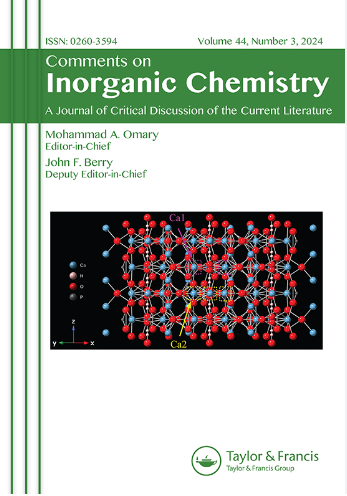Methane Manifesto: A Theorist’s Perspective on Catalytic Light Alkane Functionalization
IF 2.7
3区 化学
Q1 CHEMISTRY, INORGANIC & NUCLEAR
引用次数: 5
Abstract
The catalytic functionalization of light alkanes, particularly methane, has attracted considerable attention from the inorganic and organic research communities for nearly five decades. The literature mechanisms for C—H activation may be divided into three broad categories: metal directed, ligand directed, or metal-ligand directed. The advantages for metal-ligand directed pathways have both steric and electronic origins. Furthermore, computations suggest that the stereoelectronic requirements for the activation and functionalization component reactions can be diametrically opposed. From this research, several questions emerge for theorists that would aid in the hunt for synthesizable complexes for efficient catalytic functionalization of light alkanes. First, is there a happy medium by which a complex is nucleophilic enough to activate a alkane C—H bond with a reasonable rate, but that is not so basic as to thwart the subsequent C—O,N bond-forming step? Second, what are the energetic consequences of moving along the “ide”/“yl” continuum? Third, how can the electronic coupling among the three main catalyst components—metal, actor ligand, and spectator ligand—be modulated to permit the use of Earth-abundant catalysts to effect catalytic functionalization of light alkanes?甲烷宣言:催化轻烷烃功能化的理论家视角
近五十年来,轻烷烃特别是甲烷的催化功能化引起了无机和有机研究界的广泛关注。C-H活化的文献机制可分为三大类:金属定向、配体定向或金属-配体定向。金属配体定向途径的优点有空间和电子来源。此外,计算表明,激活和功能化组分反应的立体电子要求可以完全相反。从这项研究中,理论家们提出了几个问题,这些问题将有助于寻找可合成的配合物,以实现轻烷烃的有效催化功能化。首先,是否存在一种令人满意的介质,使络合物具有足够的亲核性,能够以合理的速率激活烷烃碳氢键,但又不至于碱性到阻碍随后的碳氧氮键形成步骤?第二,沿着“ide”/“yl”连续体移动的能量后果是什么?第三,如何调节三种主要催化剂组分(金属、参与者配体和旁观者配体)之间的电子耦合,以允许使用地球上丰富的催化剂来实现轻烷烃的催化功能化?
本文章由计算机程序翻译,如有差异,请以英文原文为准。
求助全文
约1分钟内获得全文
求助全文
来源期刊

Comments on Inorganic Chemistry
化学-无机化学与核化学
CiteScore
9.00
自引率
1.90%
发文量
18
审稿时长
>12 weeks
期刊介绍:
Comments on Inorganic Chemistry is intended as a vehicle for authoritatively written critical discussions of inorganic chemistry research. We publish focused articles of any length that critique or comment upon new concepts, or which introduce new interpretations or developments of long-standing concepts. “Comments” may contain critical discussions of previously published work, or original research that critiques existing concepts or introduces novel concepts.
Through the medium of “comments,” the Editors encourage authors in any area of inorganic chemistry - synthesis, structure, spectroscopy, kinetics and mechanisms, theory - to write about their interests in a manner that is both personal and pedagogical. Comments is an excellent platform for younger inorganic chemists whose research is not yet widely known to describe their work, and add to the spectrum of Comments’ author profiles, which includes many well-established inorganic chemists.
 求助内容:
求助内容: 应助结果提醒方式:
应助结果提醒方式:


